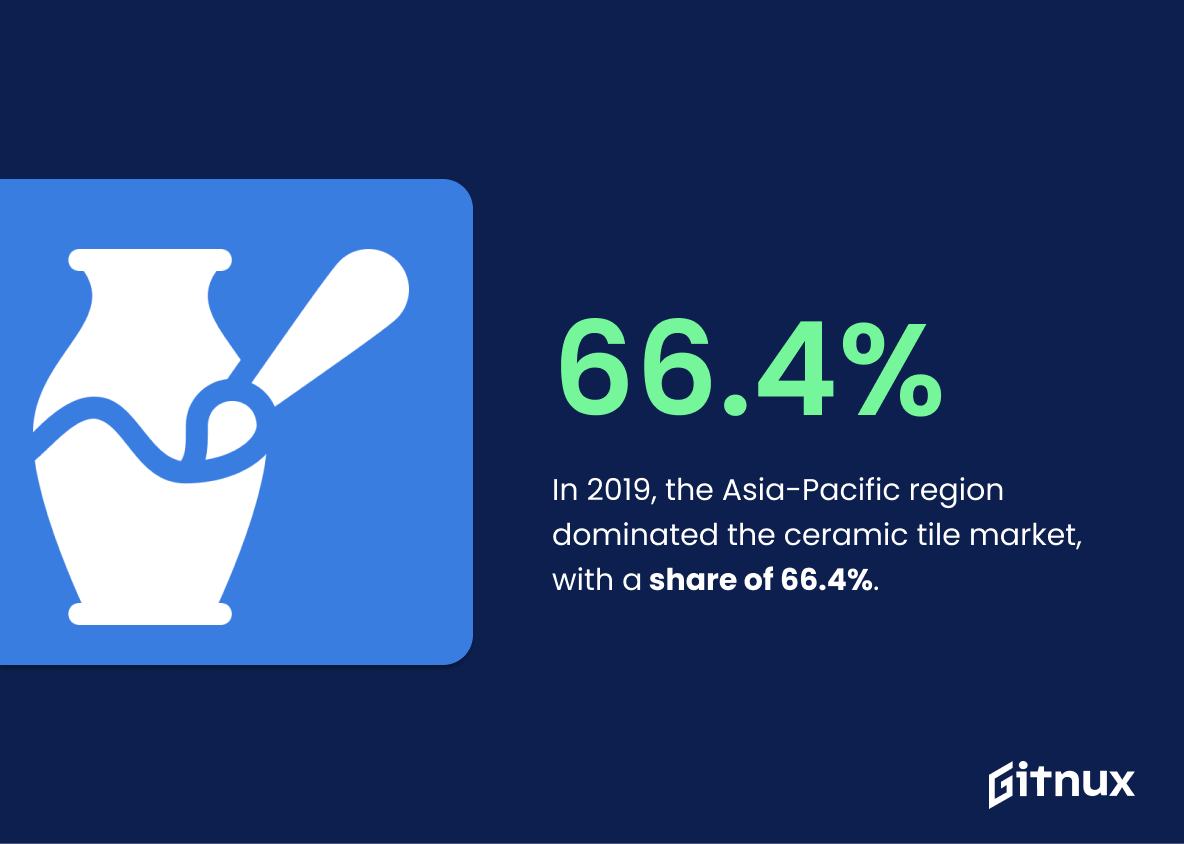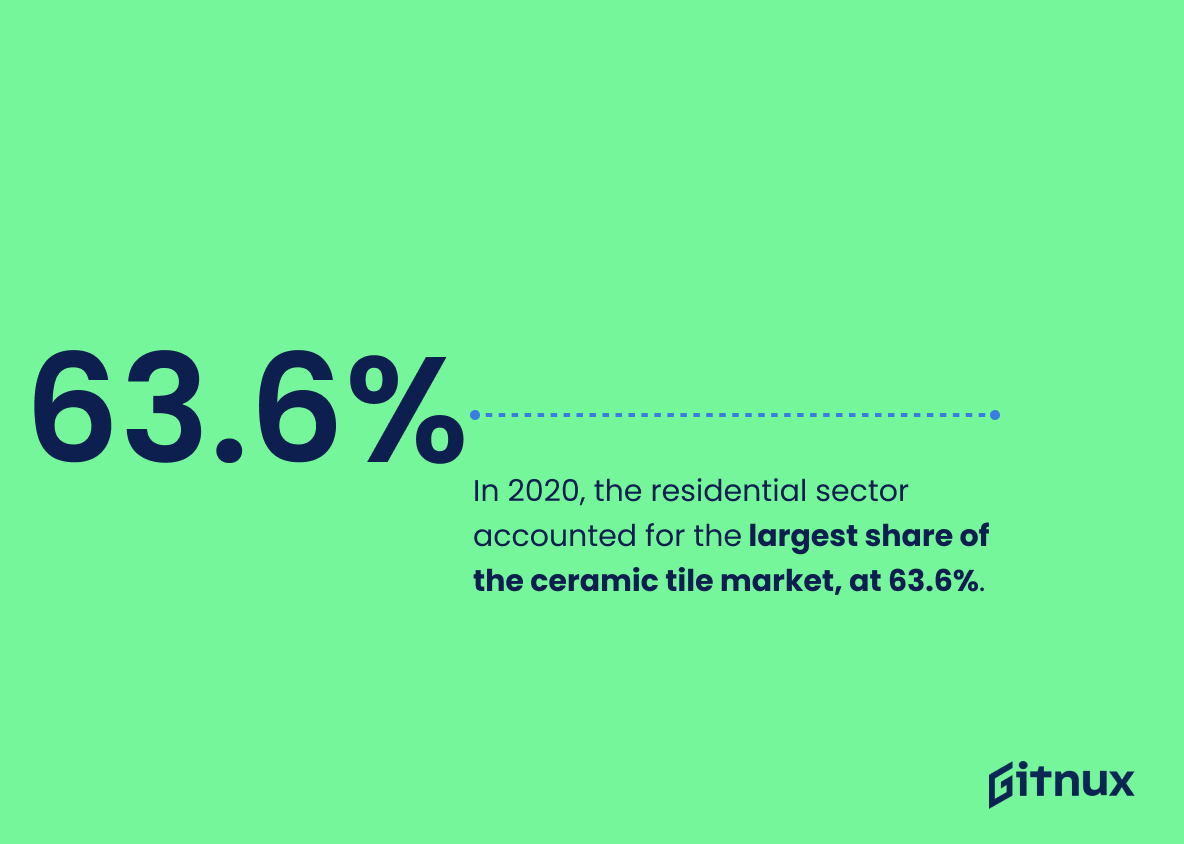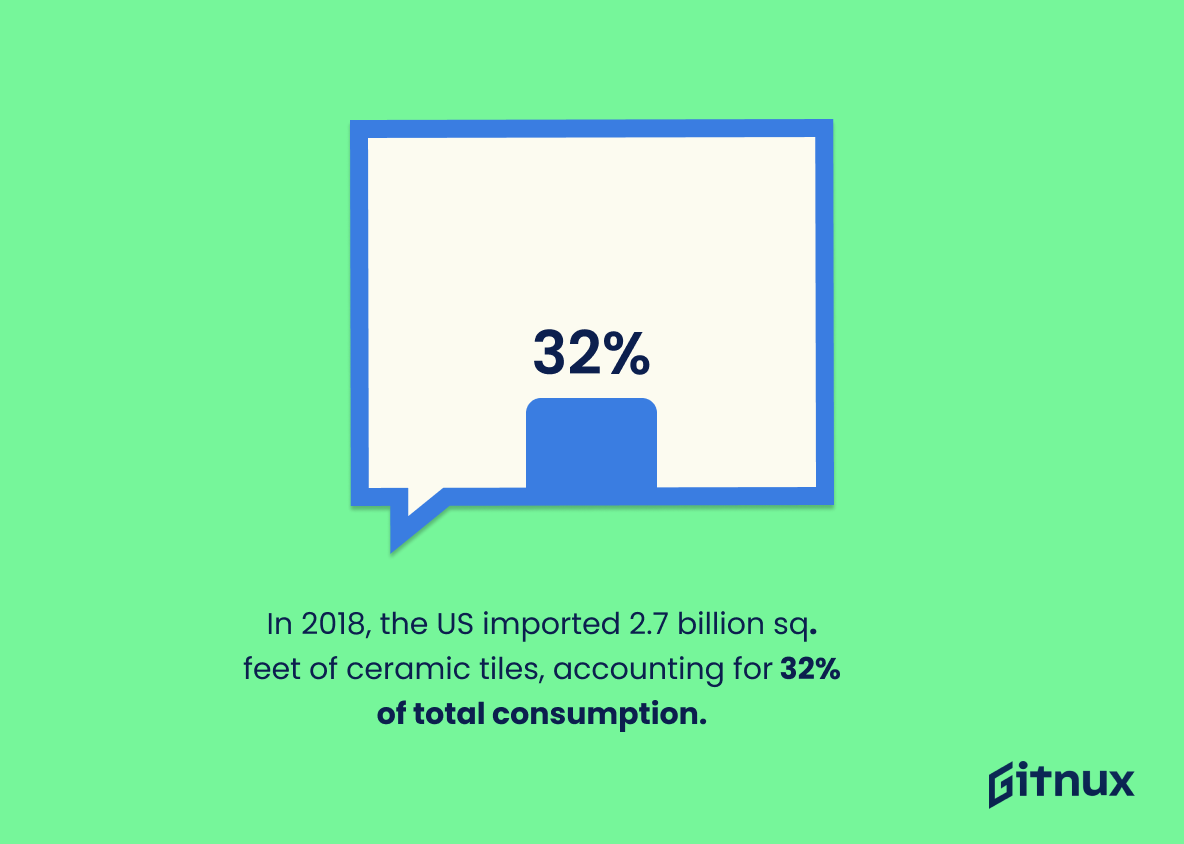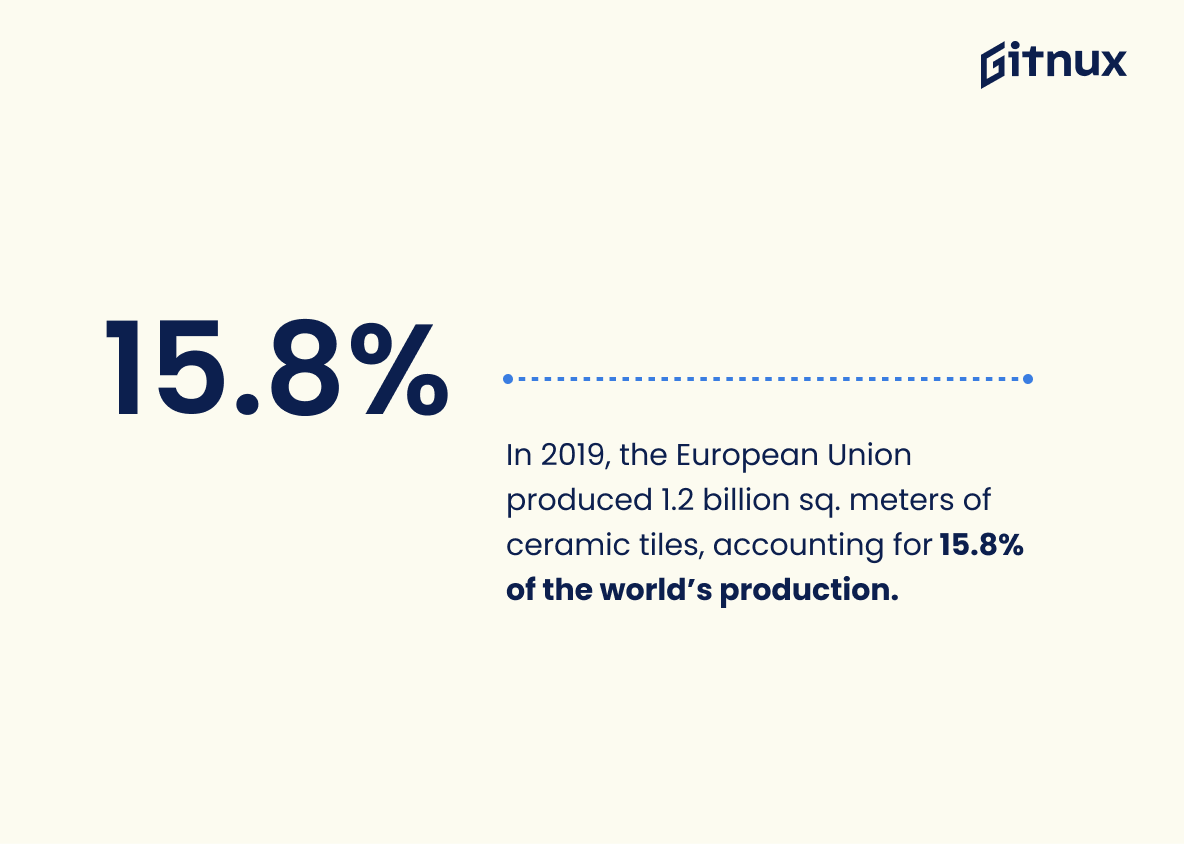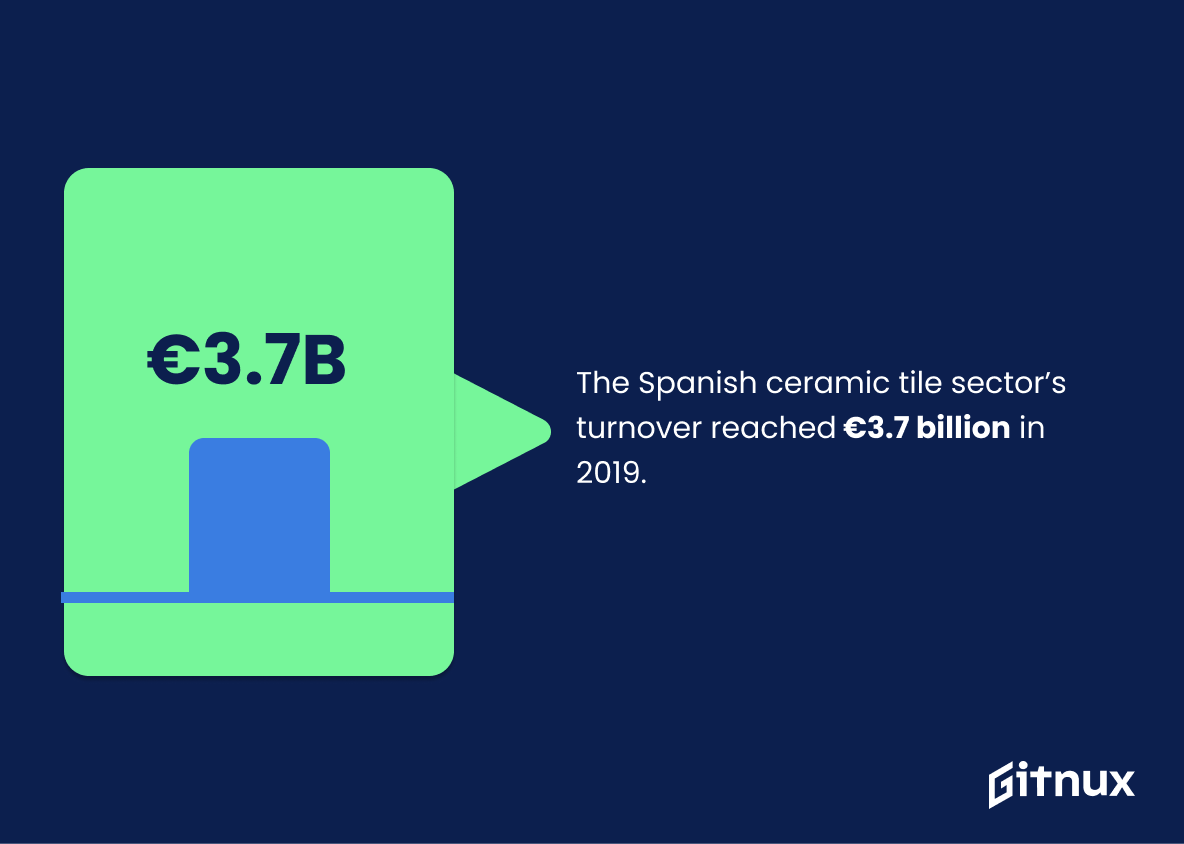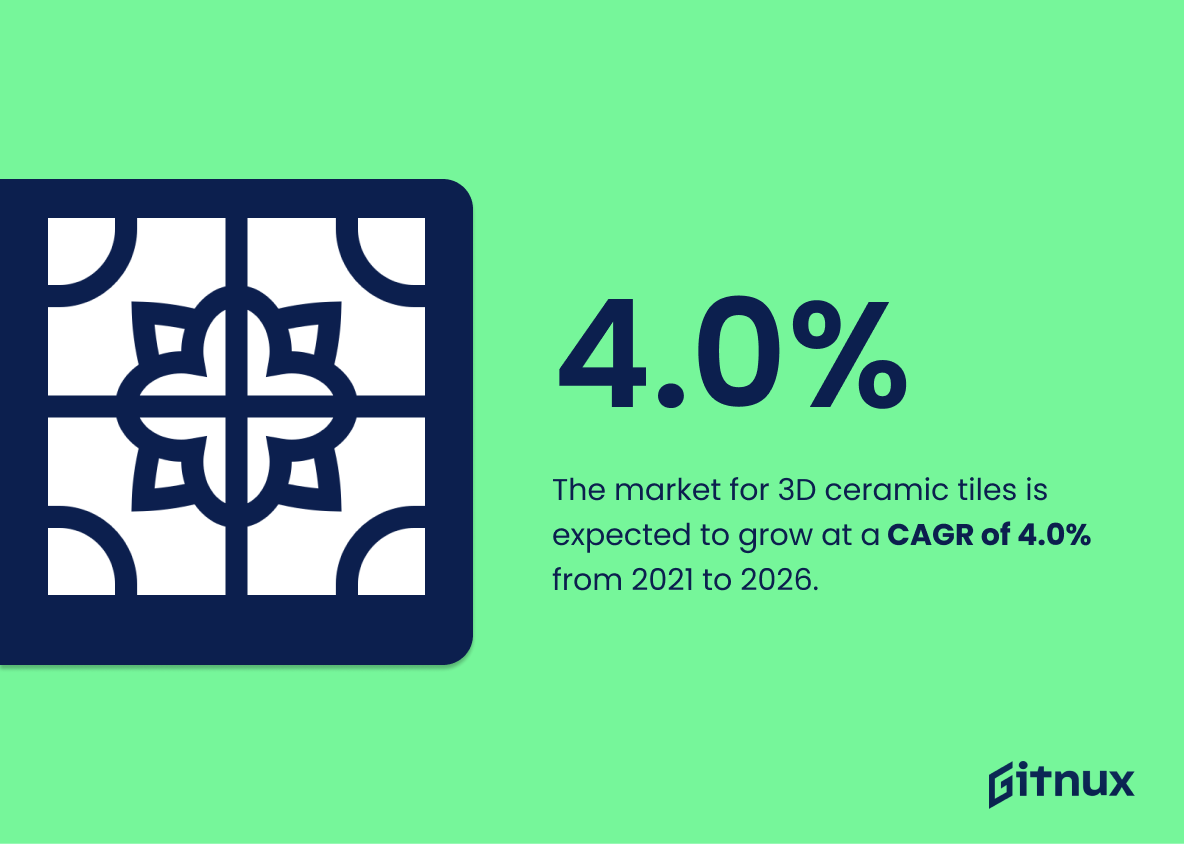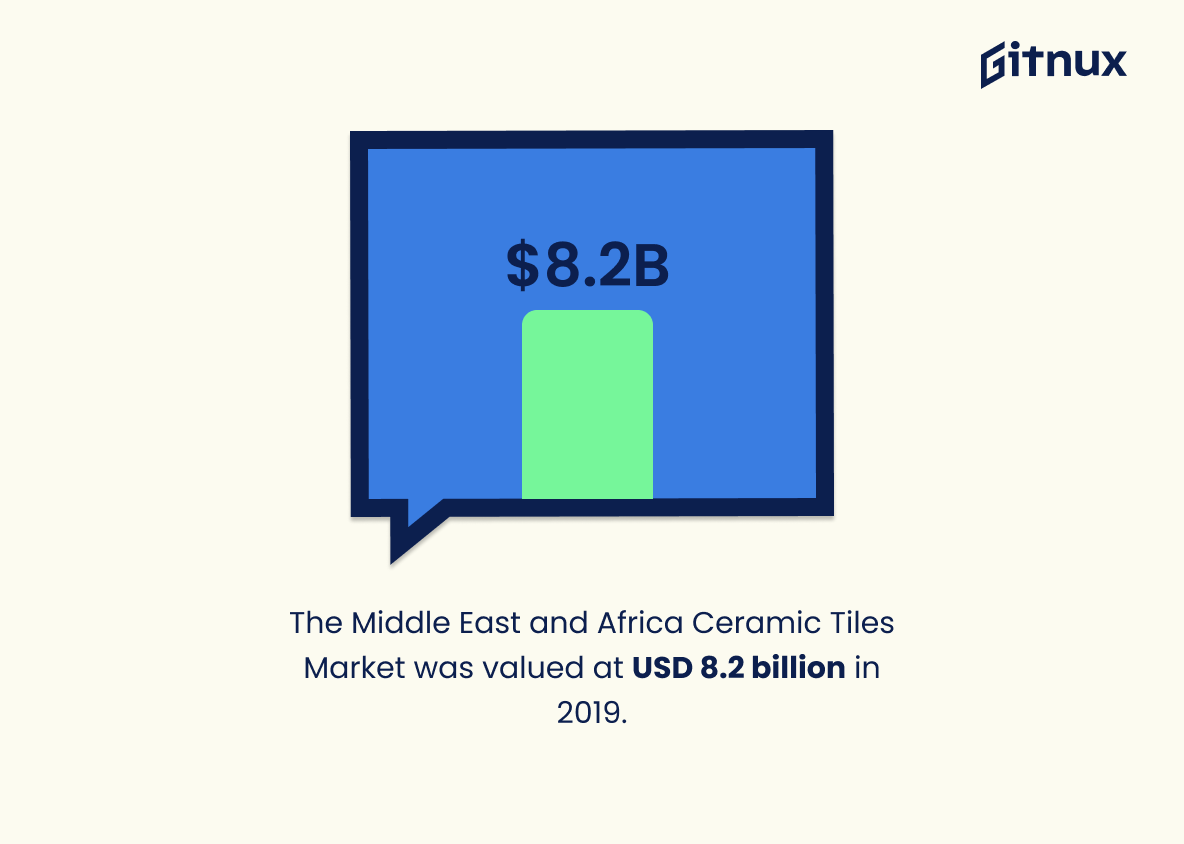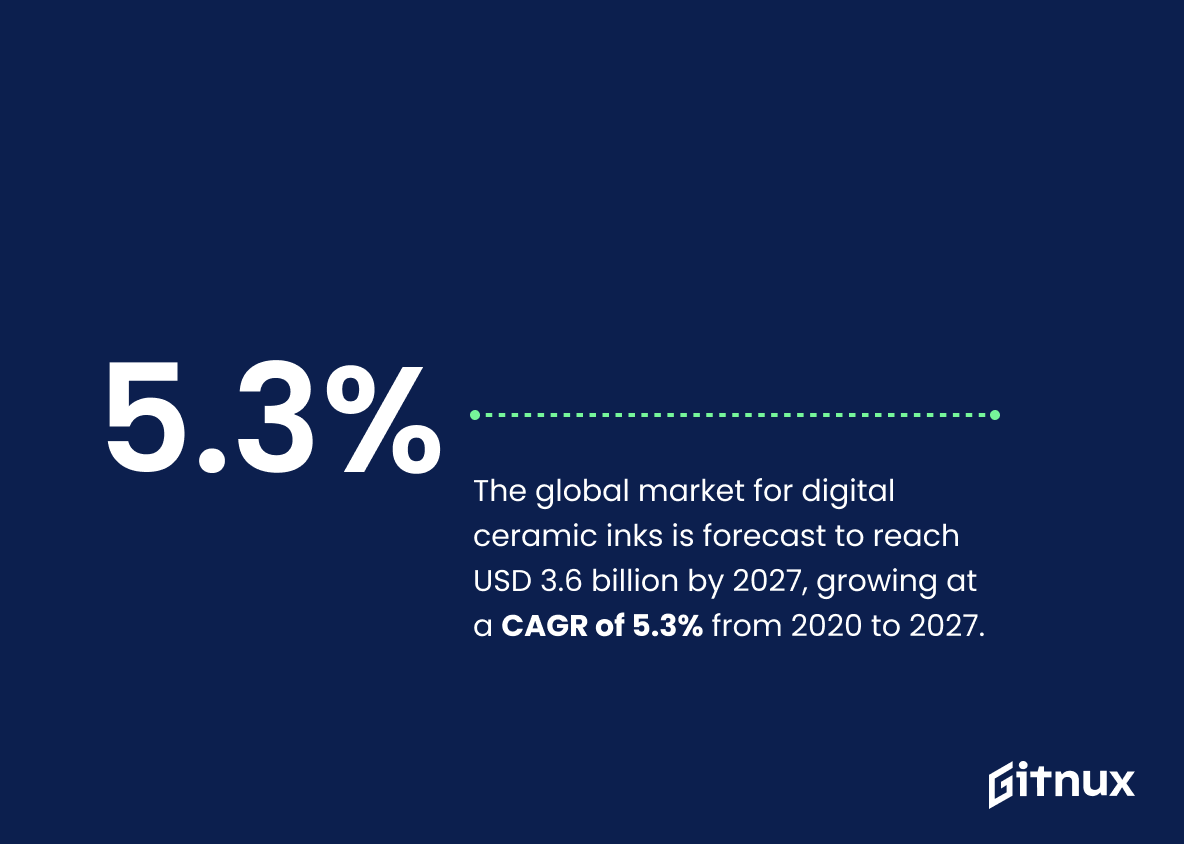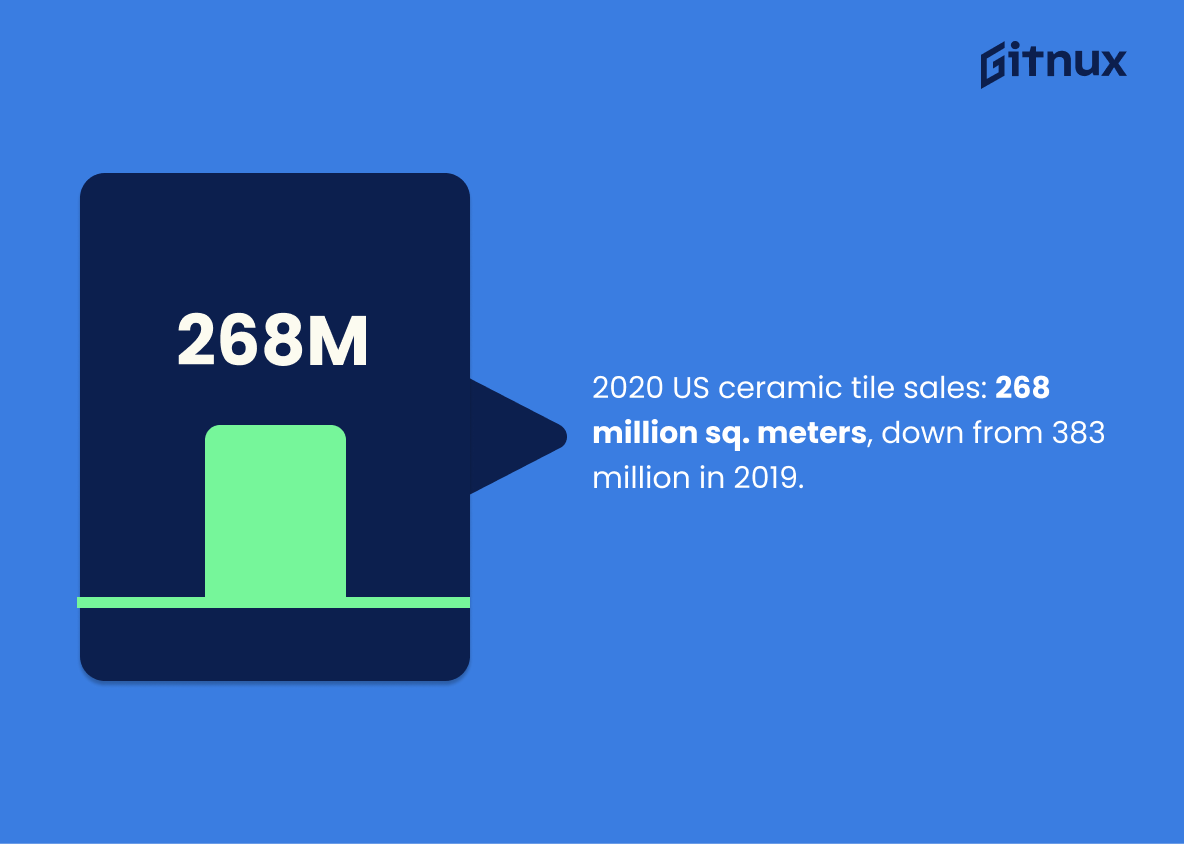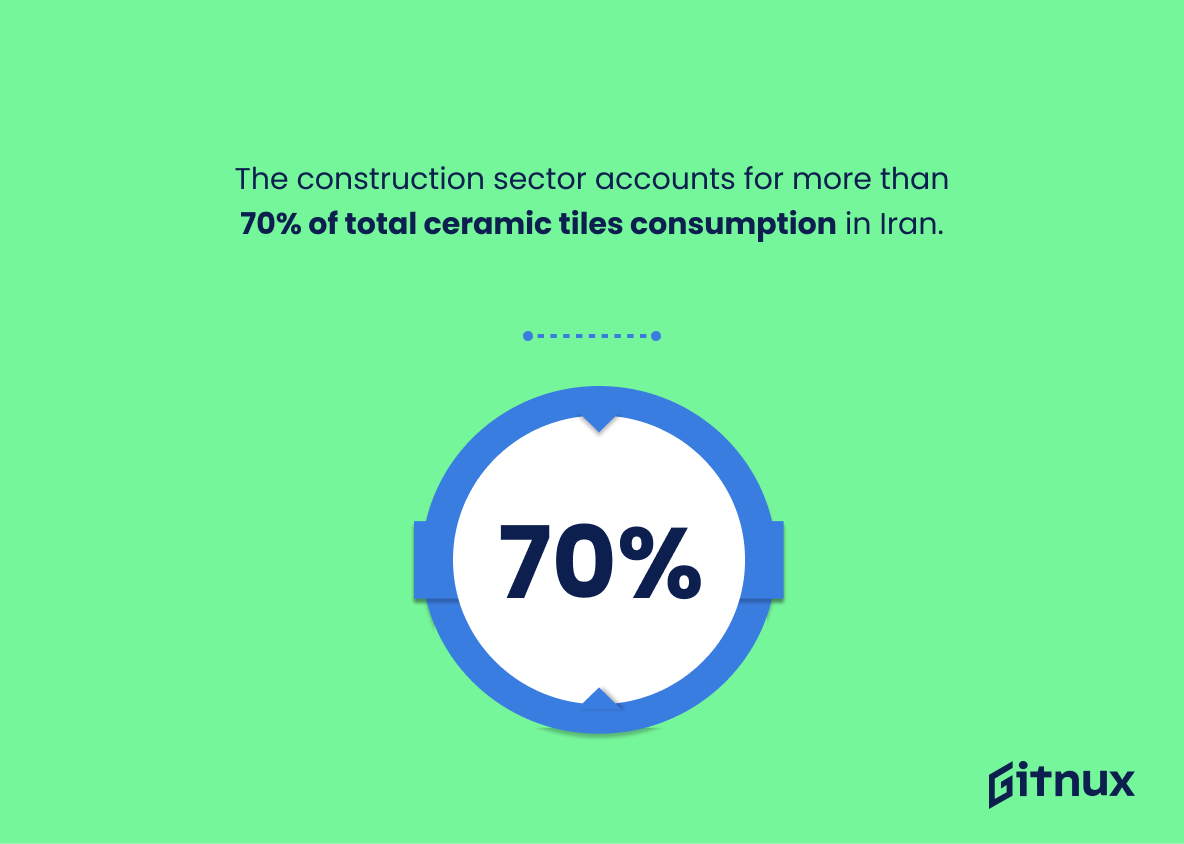The global ceramic tiles market was valued at USD 61.9 billion in 2020. It’s expected to grow at a CAGR of 6.8% from 2021 to 2028, hitting USD 120.79 billion by 2025. In 2019, the Asia-Pacific led with 66.4%, followed by Europe (17%), North America (10%), and South America (6%). In 2020, 63.6% of the tiles were consumed by the residential sector, and glazed porcelain tiles comprised 45.9% of the market. China was the top exporter in 2019, exporting goods worth 5.2 billion dollars. Italy came next, exporting 78 million sq meters that year.
Brazil was the fourth-largest consumer, meeting 6% of global demand. India’s production surged from 657 million sq meters in 2012/2013 to 1,243 million in 2019/2020. The US imported 2.7 billion square feet, 32% of its total consumption during that time. The EU contributed to 15.8% of global production, about 1.2 billion sq meters. Lastly, the Middle East & Africa’s ceramic tiles market stood at 8.2 billion dollars last year. Iran’s construction sector dominated with over 70% of domestic use. In 2018, Italy’s industry provided 36,000 direct and 100,000 indirect jobs.
Now, focusing on the core insights, let’s take a closer look at the most important statistics about ceramic tiles.
This statistic is a powerful indicator of the immense potential of the ceramic tiles market. It shows that the industry is thriving and has immense potential for growth. This statistic is a great starting point for anyone looking to gain insight into the ceramic tile industry and its current state. It provides a snapshot of the industry’s size and scope, and can be used to inform decisions about investments, strategies, and more.
The ceramic tiles market is expected to grow at a CAGR of 6.8% from 2021 to 2028.
This statistic is a crucial indicator of the potential of the ceramic tile industry. It shows that the market is expected to experience steady growth over the next few years, indicating that now is a great time to invest in the industry. This statistic is a valuable piece of information for anyone looking to gain insight into the ceramic tile industry and its future prospects.
Ceramic Tile Industry Statistics Overview
In 2019, the Asia-Pacific region dominated the ceramic tile market, with a share of 66.4%.
This statistic is a powerful indicator of the ceramic tile market’s current state. It shows that the Asia-Pacific region is the dominant force in the industry, accounting for over two-thirds of the market share. This highlights the importance of the region in the ceramic tile industry and the potential opportunities for businesses looking to capitalize on the growth of the sector.
By 2025, the global ceramic tiles market is expected to reach a value of USD 120.79 billion.
This statistic is a testament to the immense potential of the ceramic tiles market. It shows that the industry is expected to experience tremendous growth in the coming years, making it an attractive investment opportunity for those looking to capitalize on the booming industry. This statistic is a key indicator of the industry’s future success and should be taken into consideration when discussing the ceramic tile industry.
In 2020, the residential sector accounted for the largest share of the ceramic tile market, at 63.6%.
This statistic is a telling indication of the importance of the residential sector in the ceramic tile market. It highlights the fact that the residential sector is a major player in the industry, and that it is likely to remain so in the future. This is important information for anyone interested in the ceramic tile industry, as it provides insight into the current and future trends of the market.
The production of ceramic tiles in India increased from 657 million sq. meters in 2012-2013 to 1,243 million sq. meters in 2019-2020.
This statistic is a testament to the growth of the ceramic tile industry in India, demonstrating a nearly 90% increase in production over the past seven years. It is a clear indication that the industry is thriving and that demand for ceramic tiles is on the rise. This is an important statistic to consider when discussing the ceramic tile industry, as it provides insight into the current state of the industry and its potential for future growth.
Italy is the second largest exporter of ceramic tiles globally, with an export volume of 78 million sq. meters in 2018.
This statistic is a testament to Italy’s prowess in the ceramic tile industry. It highlights the country’s ability to produce and export a large volume of ceramic tiles, making it a major player in the global market. This is an important point to consider when discussing the ceramic tile industry, as it demonstrates the strength of the Italian industry and its potential to continue to be a major contributor to the global ceramic tile market.
In 2019, China was the largest exporter of ceramic tiles, with a value of USD 5.2 billion.
This statistic is a testament to the sheer size and scope of the ceramic tile industry in China. It highlights the country’s dominance in the global market, with a value of USD 5.2 billion in exports alone. This figure is indicative of the immense potential of the ceramic tile industry in China, and serves as a reminder of the importance of this sector in the global economy.
The U.S. imported nearly 2.7 billion sq. feet of ceramic tiles in 2018, which was 32% of the total ceramic tile consumption in the country.
This statistic is a telling indication of the importance of ceramic tiles in the U.S. market. It shows that ceramic tiles are a major component of the country’s total ceramic tile consumption, making up a significant portion of the total. This statistic is important for anyone interested in the ceramic tile industry, as it provides insight into the size and scope of the industry in the U.S. and the importance of ceramic tiles in the market.
In 2019, the European Union produced 1.2 billion sq. meters of ceramic tiles, accounting for 15.8% of the world’s production.
This statistic is a testament to the European Union’s dominance in the ceramic tile industry. It highlights the sheer magnitude of their production, accounting for a significant portion of the world’s total output. This statistic is an important indicator of the EU’s strength in the ceramic tile industry and provides valuable insight into the industry as a whole.
The Spanish ceramic tile sector’s turnover reached €3.7 billion in 2019.
This statistic is a testament to the success of the Spanish ceramic tile sector, demonstrating that it is a thriving industry. It shows that the sector is growing and that it is an important contributor to the Spanish economy. This statistic is a valuable insight into the ceramic tile industry and provides a useful benchmark for other countries to measure their own success against.
In 2020, glazed porcelain tiles accounted for 45.9% of the global ceramic tiles market.
This statistic is a telling indication of the current state of the ceramic tiles market. It reveals that glazed porcelain tiles are the most popular type of ceramic tile, accounting for nearly half of the global market share. This statistic is important for anyone interested in the ceramic tile industry, as it provides insight into the current trends and preferences of consumers.
The market for 3D ceramic tiles is expected to grow at a CAGR of 4.0% from 2021 to 2026.
This statistic is a key indicator of the potential for growth in the ceramic tile industry over the next five years. It suggests that the market for 3D ceramic tiles is likely to expand at a steady rate, providing a strong foundation for businesses to build upon. This is an important piece of information for anyone interested in the ceramic tile industry, as it provides a glimpse into the future of the industry and the potential for success.
The Middle East and Africa Ceramic Tiles Market was valued at USD 8.2 billion in 2019.
This statistic is a testament to the immense potential of the Ceramic Tiles Market in the Middle East and Africa. It shows that the industry is thriving and is a lucrative investment opportunity for those looking to capitalize on the growing demand for ceramic tiles in the region. It also highlights the importance of understanding the market dynamics in order to make informed decisions when it comes to investing in the industry.
The global market for digital ceramic inks is forecast to reach USD 3.6 billion by 2027, growing at a CAGR of 5.3% from 2020 to 2027.
This statistic is a powerful indicator of the potential of the ceramic tile industry. It shows that the global market for digital ceramic inks is expected to expand significantly over the next seven years, with a compound annual growth rate of 5.3%. This suggests that the ceramic tile industry is likely to experience a period of strong growth, providing a great opportunity for businesses to capitalize on the increasing demand for ceramic tiles.
In 2020, the sales volume of ceramic tiles in the United States reached 268 million sq. meters, down from 383 million sq. meters in 2019.
This statistic is a telling indication of the impact of the pandemic on the ceramic tile industry in the United States. It shows that the sales volume of ceramic tiles in the US has dropped significantly in 2020, compared to the previous year. This is an important piece of information for anyone interested in the ceramic tile industry, as it provides insight into the current state of the industry and the challenges it is facing.
The construction sector accounts for more than 70% of total ceramic tiles consumption in Iran.
This statistic is a powerful indicator of the importance of the construction sector in the Iranian ceramic tile industry. It shows that the construction sector is the primary driver of ceramic tile consumption in Iran, and thus is a major factor in the success of the industry. This statistic is essential for understanding the dynamics of the ceramic tile industry in Iran, and provides valuable insight into the industry’s current and future prospects.
Conclusion
The global ceramic tiles market is a rapidly growing industry, with the size of the market estimated to reach USD 120.79 billion by 2025 and expected to grow at a CAGR of 6.8% from 2021 to 2028. The Asia-Pacific region dominates this sector, accounting for 66.4% of the total share in 2019, followed by Europe and North America respectively.
Residential applications account for 63.6% of all ceramic tile consumption worldwide while glazed porcelain tiles make up 45.9%. In terms of production volume, Italy was second only to China in 2018 as an exporter with 78 million sq meters exported that year; India has seen significant growth over recent years increasing its production from 657 million sq meters in 2012-2013 to 1 243 million sq meters in 2019-2020; Brazil is also one of the largest markets globally accounting for 6%, while Spain’s turnover reached €3 7 billion last year alone due largely thanks their construction sector which accounts for more than 70%. Digital ceramic ink sales are forecasted to reach USD 3 69 billion by 2027 showing further potential within this industry going forward into future years
References
0. – https://www.globenewswire.com
1. – https://www.statista.com
2. – https://www.exportgenius.in
3. – https://www.ibef.org
4. – https://www.tridge.com
5. – https://www.tile-magazine.com
6. – https://www.worldofchemicals.com
7. – https://www.mordorintelligence.com
8. – https://www.researchandmarkets.com
9. – https://www.grandviewresearch.com
10. – https://www.floordaily.net
11. – https://www.menafn.com
12. – https://www.marketsandmarkets.com
13. – https://www.marketdataforecast.com
